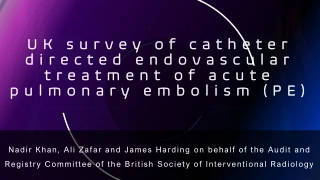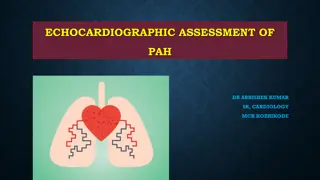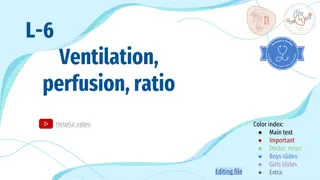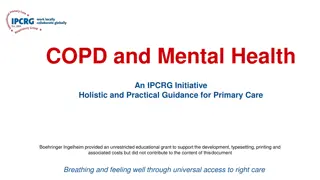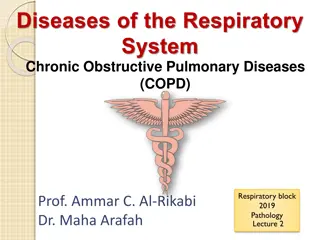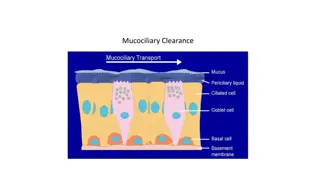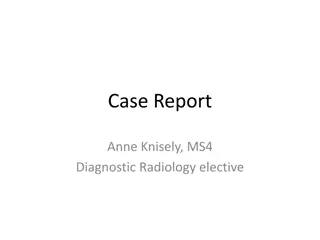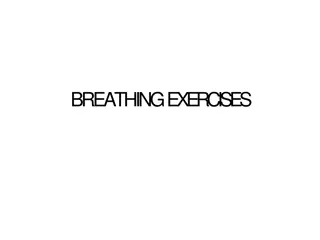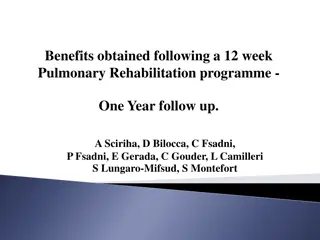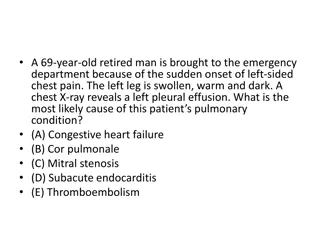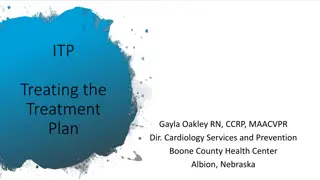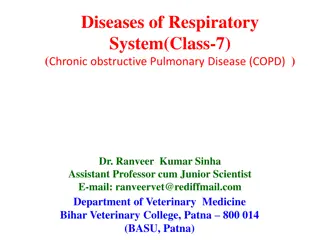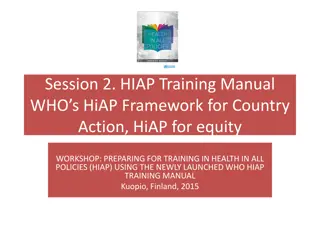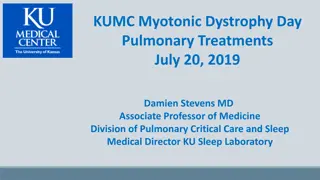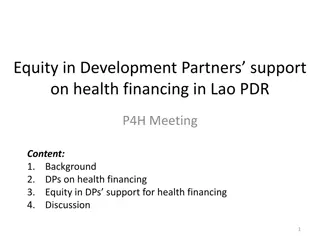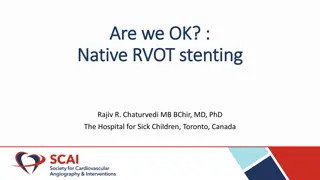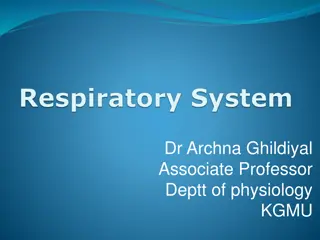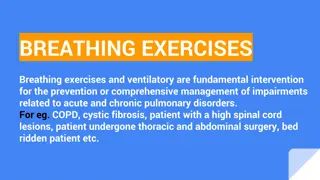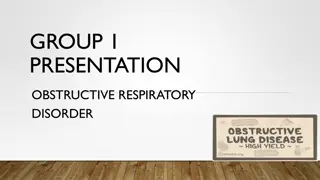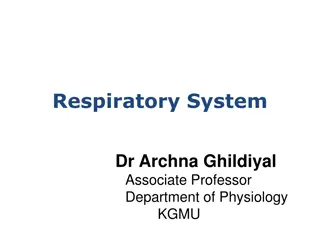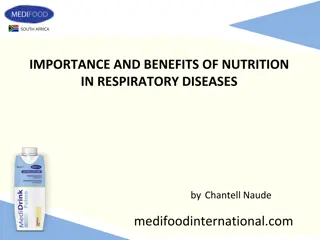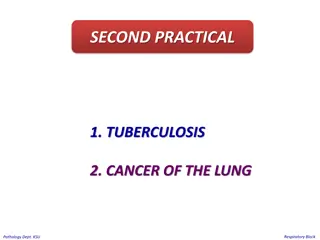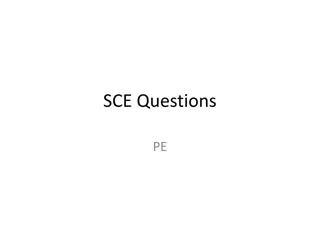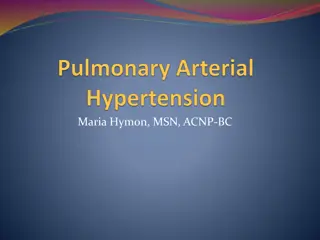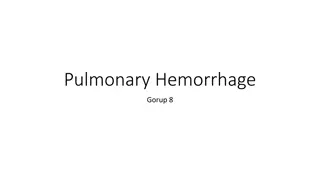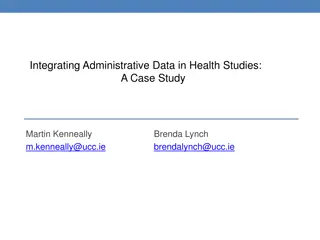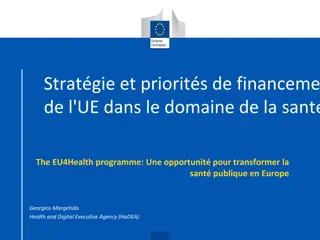UK Survey on Endovascular Treatment of Acute Pulmonary Embolism
Acute pulmonary embolism (PE) is a significant issue in hospitalized patients, with current treatments focusing on anticoagulation and systemic thrombolysis. Surgical treatments have shown poor outcomes, leading to a rise in endovascular techniques aimed at reducing clot burden. A survey conducted i
0 views • 12 slides
Pulmonary and Critical Care Lecture Highlights: Bronchiectasis and Sarcoidosis Overview
Dive into the realm of pulmonary and critical care as Dr. Michael Forte discusses the intricacies of bronchiectasis and sarcoidosis. Understand the etiologies, diagnosis, investigations, and treatment options for these respiratory conditions. Explore the challenges and nuances of managing patients w
0 views • 35 slides
Periodontal Treatment Considerations for Medically Compromised Patients
Patients with significant medical conditions may require special considerations for periodontal treatment. Medical issues such as hemorrhagic disorders, renal diseases, liver diseases, pulmonary diseases, infectious diseases, pregnancy, medications, and cancer therapies can impact oral health and tr
1 views • 87 slides
Radiographic Imaging Methods of the Respiratory System
Radiographic imaging plays a crucial role in the evaluation and diagnosis of thoraco-mediastino-pleuro-pulmonary conditions. Techniques like radioscopy, digital radiography, computer tomography, magnetic resonance imaging, conventional pulmonary angiography, and hybrid imaging methods offer detailed
10 views • 21 slides
Statewide Pulmonary Rehabilitation Project Overview
The Statewide Pulmonary Rehabilitation Project, funded by Clinical Excellence Queensland, aims to enhance care models for chronic lung diseases like COPD and asthma. The project explores virtual rehabilitation integration, ensuring equity and improved access for patients. Challenges include resource
4 views • 21 slides
Echocardiographic Assessment of Pulmonary Arterial Hypertension (PAH) Overview
Echocardiographic assessment plays a crucial role in the diagnosis, management, and prognostic evaluation of pulmonary arterial hypertension (PAH). This condition is characterized by elevated mean pulmonary arterial pressure and pulmonary vascular resistance, leading to various clinical features suc
6 views • 43 slides
Understanding Pulmonary Circulation and V/Q Ratio in Respiratory Physiology
Explore the high-pressure and low-pressure circulations supplying the lungs, the concept of physiological shunt in pulmonary circulation, different lung zones based on blood flow, V/Q ratio and its clinical significance, and abnormal V/Q ratio patterns. Delve into the role of pulmonary circulations
11 views • 28 slides
Understanding Pulmonary Circulation and Its Importance in Respiratory Physiology
Pulmonary circulation, as explained by Professor Narsingh Verma, plays a crucial role in the respiratory system, showcasing distinct differences from systemic circulation. The low pressure and resistance in pulmonary circulation allow for optimal gas exchange at the alveolocapillary membrane. Variou
1 views • 30 slides
Comprehensive Overview of Pulmonary Function Tests (PFTs)
Pulmonary Function Tests (PFTs) are vital for assessing pulmonary gas exchange through ventilation, diffusion, and lung perfusion. These tests include measurements of lung volume, airway patency, gas exchange efficacy, and pulmonary blood flow. PFTs offer benefits in diagnosing dyspnea, monitoring d
0 views • 14 slides
Comprehensive Guidance on COPD and Mental Health in Primary Care
This document, supported by an educational grant, offers holistic guidance on managing chronic obstructive pulmonary disease (COPD) and mental health in primary care settings. It includes case studies, glossary of terms, and practical information for healthcare professionals to provide optimal care
0 views • 27 slides
Understanding Chronic Obstructive Pulmonary Diseases (COPD) and Emphysema
Chronic Obstructive Pulmonary Diseases (COPD) encompass conditions like chronic bronchitis and emphysema, typically caused by factors like cigarette smoking. This presentation delves into the clinical and functional variances between chronic bronchitis and emphysema in COPD patients, along with an e
1 views • 40 slides
Respiratory Health Imaging Studies and Evaluation
Explore a series of informative images showcasing various respiratory health evaluations and studies, including mucociliary clearance, cough clearance measured by gamma scintigraphy, pulmonary deposition of inhaled aerosol therapies, and assessment of fitted filtration efficiency using specialized p
1 views • 5 slides
Case Report: Submassive Bilateral Pulmonary Embolism in a 69-Year-Old Female
Anne Knisely, a 69-year-old female with a history of endometrial cancer, presented with left leg pain, pleuritic chest pain, and shortness of breath. Imaging revealed extensive bilateral pulmonary emboli, right heart strain, and lower extremity deep vein thrombi. She was managed with anticoagulation
3 views • 11 slides
Understanding Hantavirus Pulmonary Syndrome: Diagnosis and Clinical Review
This content provides an in-depth overview of Hantavirus Pulmonary Syndrome, including its clinical presentation, diagnosis, and management. It covers key points such as incubation periods, symptoms, and diagnostic tests like ELISA. The information emphasizes the need for a high index of suspicion d
0 views • 24 slides
Understanding the Importance of Breathing Exercises in Respiratory Management
Breathing exercises, also known as ventilatory training, play a crucial role in improving pulmonary status, enhancing endurance, and increasing overall functionality in daily activities. These exercises help retrain respiratory muscles, improve ventilation, reduce breathing effort, enhance gas excha
0 views • 32 slides
Pulmonary Rehabilitation: Benefits of a 12-Week Program - One Year Follow-Up
This study focuses on the benefits obtained from a 12-week pulmonary rehabilitation program with a one-year follow-up. The program includes scientifically based diagnostic management, multidisciplinary approach, exercise, and education. A baseline assessment was conducted before enrollment, and pati
0 views • 23 slides
Pulmonary Conditions and Hemodynamic Disorders: Clinical Cases
A 69-year-old man with chest pain and pleural effusion presents with thromboembolism; a 22-year-old worker with fractures develops shock due to fat embolism; a postpartum woman dies from amniotic fluid embolism. The cases illustrate conditions like pulmonary embolism, fat embolism, and amniotic flui
0 views • 26 slides
Comprehensive Approach to Treatment Planning in Cardiac and Pulmonary Rehabilitation
The duties of an Individualized Treatment Plan (ITP) in cardiac and pulmonary rehabilitation encompass a holistic approach involving exercise, nutrition, psychosocial aspects, and individualized components specific to each patient. Compliance with CMS Conditions of Coverage and a thorough understand
4 views • 37 slides
Chronic Obstructive Pulmonary Disease (COPD) in Horses: A Veterinarian's Perspective
Chronic Obstructive Pulmonary Disease (COPD) in horses is a respiratory condition caused by hypersensitivity reactions to allergens, viral infections, or bronchopneumonia. This chronic respiratory disease leads to decreased work performance, chronic coughing, abnormal lung sounds, and cardiac dysfun
0 views • 17 slides
WHO's HiAP Framework and Global Mandates for Health Equity
This content discusses the HiAP Framework for Country Action and Global Mandates for promoting health equity. It covers resolutions, declarations, and recommendations by various organizations to address social determinants of health and reduce health inequities. The WHO Director-General is urged to
0 views • 11 slides
Pulmonary and Sleep Management in Myotonic Dystrophy
Myotonic dystrophy presents challenges in respiratory and sleep function. The condition can lead to pulmonary complications, such as ineffective cough, pneumonia, and respiratory failure, making proactive management crucial. Treatment strategies include vaccinating against infections, utilizing vent
0 views • 10 slides
Pulmonary Hydrotherapy: Innovation in Exercise for COPD Patients
Pulmonary hydrotherapy is being explored as a safe and effective form of exercise for COPD patients, challenging previous beliefs about water-based activities. South Tees Pulmonary Rehabilitation Service is examining the benefits of hydrotherapy in improving exercise capacity and quality of life, ba
1 views • 10 slides
Equity in Development Partners Support on Health Financing in Lao PDR P4H Meeting
The meeting focuses on addressing health indicators, inequities, and health financing challenges in Lao PDR. It analyzes the background of health indicators, inequities by socio-economic status and ethnic groups, and the current health financing situation in the country. The discussion delves into s
0 views • 23 slides
Challenges and Techniques in Native RVOT Stenting for TOF+PS Patients
Native RVOT stenting in TOF+PS patients can be challenging due to anatomical complexities like short infundibulum and VSD. Different equipment and techniques are used for crossing tricuspid and pulmonary valves and delivering the stent. Dilating the pulmonary valve and addressing residual stenosis a
0 views • 22 slides
Mechanics of Pulmonary Ventilation and Respiratory Cycle Explained
Understanding the mechanics of pulmonary ventilation is crucial for comprehending the breathing process. This comprehensive overview covers the role of muscles, ribs, pressure changes in alveolar, pleural, and transpulmonary regions, terms related to breathing and ventilation, and the contraction an
0 views • 31 slides
Breathing Exercises for Pulmonary Health
Breathing exercises are essential interventions for managing pulmonary disorders like COPD, cystic fibrosis, and post-operative complications. They help improve ventilation, cough effectiveness, muscle strength, and reduce stress. Different types of exercises like diaphragmatic breathing and pursed
0 views • 13 slides
Understanding Pulmonary Emphysema: Symptoms, Causes, and Pathophysiology
Pulmonary emphysema, a type of obstructive respiratory disorder, is a progressive lung disease that affects the air spaces in the lungs. This condition is primarily caused by long-term exposure to irritants like tobacco smoke and air pollution. The damage to the alveoli leads to symptoms such as sho
0 views • 49 slides
Overview of Respiratory System Components and Functions
The respiratory system consists of vital components like pulmonary compliance and surfactant, crucial for proper lung function. Pulmonary compliance reflects the lung's ease of expansion, influenced by factors like lung elasticity and surface tension. Surfactant, produced by type II alveolar cells,
0 views • 15 slides
Pulmonary Abnormalities and Their Physiologic Effects
Chronic pulmonary emphysema is a complex obstructive and destructive lung condition typically caused by smoking. It leads to chronic infection, excessive mucus production, airway obstruction, and lung tissue destruction. The physiological effects of emphysema include hypoxia, hypercapnia, and severe
0 views • 12 slides
Understanding Respiratory System: Lectures on Alveoli Stability, Compliance, and More
Dive into the complexities of the respiratory system with these enlightening lectures covering topics such as the stability of alveoli, lung compliance, airway resistance, surface tension, and the interdependence of alveoli. Gain insights into the factors affecting pulmonary ventilation and learn ab
0 views • 32 slides
Postural Drainage Therapy for Airway Clearance
Postural drainage therapy is an intervention used for airway clearance by mobilizing secretions in specific lung segments towards the central airways. It involves placing the patient in various positions to facilitate gravity-assisted drainage. The therapy includes manual techniques such as percussi
0 views • 13 slides
Importance and Benefits of Nutrition in Respiratory Diseases
Nutrition plays a crucial role in respiratory diseases such as COPD and CF, with malnutrition affecting a significant percentage of patients. Poor nutritional status is linked to increased morbidity and mortality in these patients, impacting pulmonary health and muscle function. MediDrink Pulmo offe
0 views • 7 slides
Pulmonary Tuberculosis and Lung Cancer Images in Respiratory Pathology Dept. KSU
Images showcasing various aspects of pulmonary tuberculosis (TB) and lung cancer in the respiratory pathology department at KSU. The pictures include Ghon's complex, caseous necrosis, miliary TB, tuberculous granulomas, and more, providing visual insights into the conditions and their pathological m
0 views • 39 slides
Comprehensive Guide to Cardiovascular Imaging and Anatomy
Explore a detailed collection of images showcasing cardiovascular imaging, radiological anatomy of the chest, vascular anatomy, and pulmonary conditions like embolism. Discover the gold standard for diagnosing pulmonary embolism, as well as CT angiograms and aortic arch anatomy. Engage with visuals
0 views • 59 slides
Understanding Haemodynamic Consequences of Acute Pulmonary Embolism
Haemodynamic consequences of acute pulmonary embolism (PE) include increased mean pulmonary artery pressure, rise in right ventricular preload and end-diastolic pressure, risk of right ventricular failure, and decreased pulmonary blood flow leading to low systolic blood pressure. Arterial hypoxia ca
0 views • 18 slides
Understanding Pulmonary Arterial Hypertension (PAH): Causes, Symptoms, and Management
Pulmonary Arterial Hypertension (PAH) is a progressive disease characterized by increased blood pressure in the pulmonary artery, veins, or capillaries. This condition can lead to right ventricular failure and eventual death if left untreated. PAH can have various causes, including idiopathic factor
0 views • 49 slides
Sudden Death and Pulmonary Embolism in a Forensic Medicine Case Study
A 57-year-old woman admitted for abdominal pain tragically dies from a pulmonary embolism after collapsing outside the hospital. This case study delves into the definition of sudden death, major causes within the respiratory organs, and predisposing factors like deep vein thrombosis. References incl
0 views • 5 slides
Overview of Pulmonary Hemorrhage in Infants
Pulmonary hemorrhage in infants is a severe condition characterized by bloody discharge from the upper respiratory tract or endotracheal tube, often associated with prematurity, lung complications, infections, or trauma. The etiology, pathophysiology, clinical manifestations, and diagnosis of pulmon
0 views • 14 slides
Integrating Administrative Data in Health Studies: A Case Study
This case study explores the integration of administrative data in health studies focusing on profiling the health status of Irish regions in 2010. The objectives include linking regional health profiles to prescribing patterns, incorporating demographics and drug scheme coverage rates, and simulati
0 views • 17 slides
EU4Health Programme: Transforming Public Health in Europe
The EU's financial strategy and priorities in the health domain are highlighted through the EU4Health programme, aiming to enhance public health in Europe. The HaDEA is actively involved in improving health in the Union, protecting against cross-border health threats, ensuring availability of afford
0 views • 11 slides
